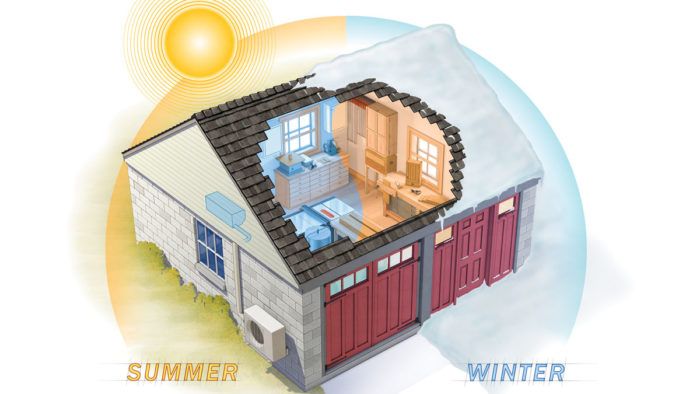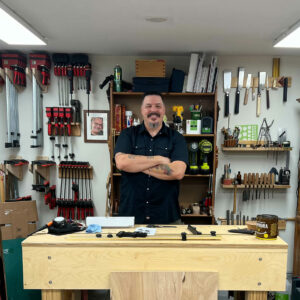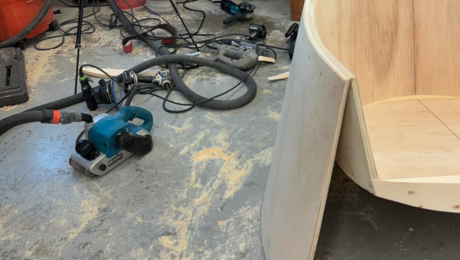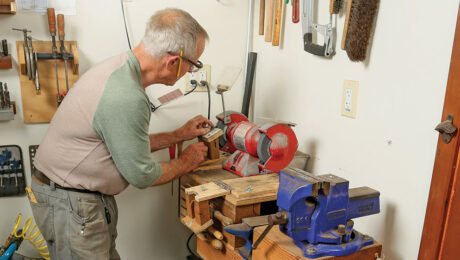Heating and Cooling Your Shop
Ductless HVAC systems ensure that the weather doesn't limit your shop time
A freestanding building can be a fantastic place for a wood shop. But you can’t usually hook it up to the heating and cooling systems in your house, and if you live where winter days regularly fall below freezing or humid summer days linger above 90°—or both—the shop will be uncomfortable or unusable for chunks of the year. Plus, weather swings can wreak havoc on tools and materials. If you need to heat and cool a freestanding shop—or a garage that’s attached to your house but not to its heating and cooling system—a mini-split or PTAC may be the answer.
These ductless air conditioners or air-conditioner/heater combos are easy to install compared with ducted systems, don’t take up much space, and require only a 220-volt circuit. Plus, they can come with you if you move. Both mini-splits and PTACs (packaged terminal air conditioners) are heat pumps. For cooling, they extract heat from a room and send it outside. If they can heat as well, they flip the operation, pulling warmth from outside and bringing it in (both are thanks to the seeming magic of refrigerant). Because heat pumps move heat rather than generate it, they can be more efficient than other heating methods, such as electric resistance and, generally, fossil fuels. Some heat pumps have limits: PTACs have trouble drawing warmth from the outside below 35° to 40°. They turn to electric resistance heat in colder temperatures. Mini-splits can handle much colder weather; some as low as –15°F. However, they cost a lot more up front, in part because it’s advisable to use a pro for installation. Still, they can keep energy bills lower thanks to their efficiency. To get the most out of either type, your shop should be well insulated and well sealed. (For tips on insulation, see Shop Design, pp. 30–33.) If the building is leaky, you might as well slip the dollars through the cracks in your wall instead.






















Comments
Couldn't agree more. Living in Florida I needed to protect my equipment from the humidity and on rare occasions a little heat to take the chill off. I installed a Mitsubishi unit after I had my building completely spray foamed with closed cell. After installation I saw no increase in my electric bill. Installing a mini split was one of my best decisions.
I did however have two problems with the Mitsubishi units. I had to replace the inside unit due to a leak that could not be fixed and the second unit developed a leak in the exact same spot as the first unit. A friend suggested a leak substance that is injected directly into the refrigerant line (similar to the old Barrs leak we used in our car radiators). That did the trick. Having to do it again I would not purchase a Mitsubishi mini split. Additionally I use a pleated filter over the intake to keep fine sawdust out of the fins.
I recently installed an Innova Inverter mini-split in my 20 x 20 attached garage workshop. The house heat pump was not sized to include the garage space. The heat and humidity here in SE NC is pretty bad during the summer and the winters are chilly certain days, those two factors limited my shop time but also wreaked havoc on my metal tools, glues and containers of finishes. I insulated only the ceiling with R30 and that was enough to keep it very comfortable. I'm so glad I finally can work comfortably year round making sawdust.
Best thing I ever did. Stops all the tools from rusting
I've now provisioned two separate shops with mini-splits, one from Senville and the other Pioneer. Both were good units, although because the shops were of different sizes and shapes (one was a single story @1,440sf and the other with a high loft @ 1,100sf) the installation and operation was a little different. The goal was to incur the lowest cost and still maintain 62-68 degrees all day. It's true that the mini-splits cost a little more to purchase and set up, but if you look at the 5-year cost of ownership and operations they are much (MUCH) less expensive. There are two setup tips:
1) Insulate, insulate, insulate and then put a little more insulation in. While insulation is not free, it is like money in the bank when it comes to heating. Plus, go around with a can of spray foam and spray it anywhere there is a crack, hole, gap, etc.
2) Put the heat exchanger (the inside unit) in a central location where it can blow the air throughout the shop space. On my shop with the loft I put a ceiling fan in the middle to blow the warm air down to the lower level and circulate the air as much as possible (on medium speed it only uses +/- 40 watts).
I'm also convinced that you want to get a mini-split and use the higher BTU calculation. In other words, if you have 600sf to heat/cool and your choice is either a 12,000BTU unit or 18,oooBTU unit, get the 18,000BTU unit. It won't work as hard to condition the same space and the cost to purchase and operate will be negligible.
Good info. I am moving my shop from the garage to a stand-alone 10' x 20' dedicated structure. Small space, clearly need to manage the SFT. I'm in Maryland, get all 4 seasons, winter not real bad. what do you recommend?
thanks
Jerry
Log in or create an account to post a comment.
Sign up Log in